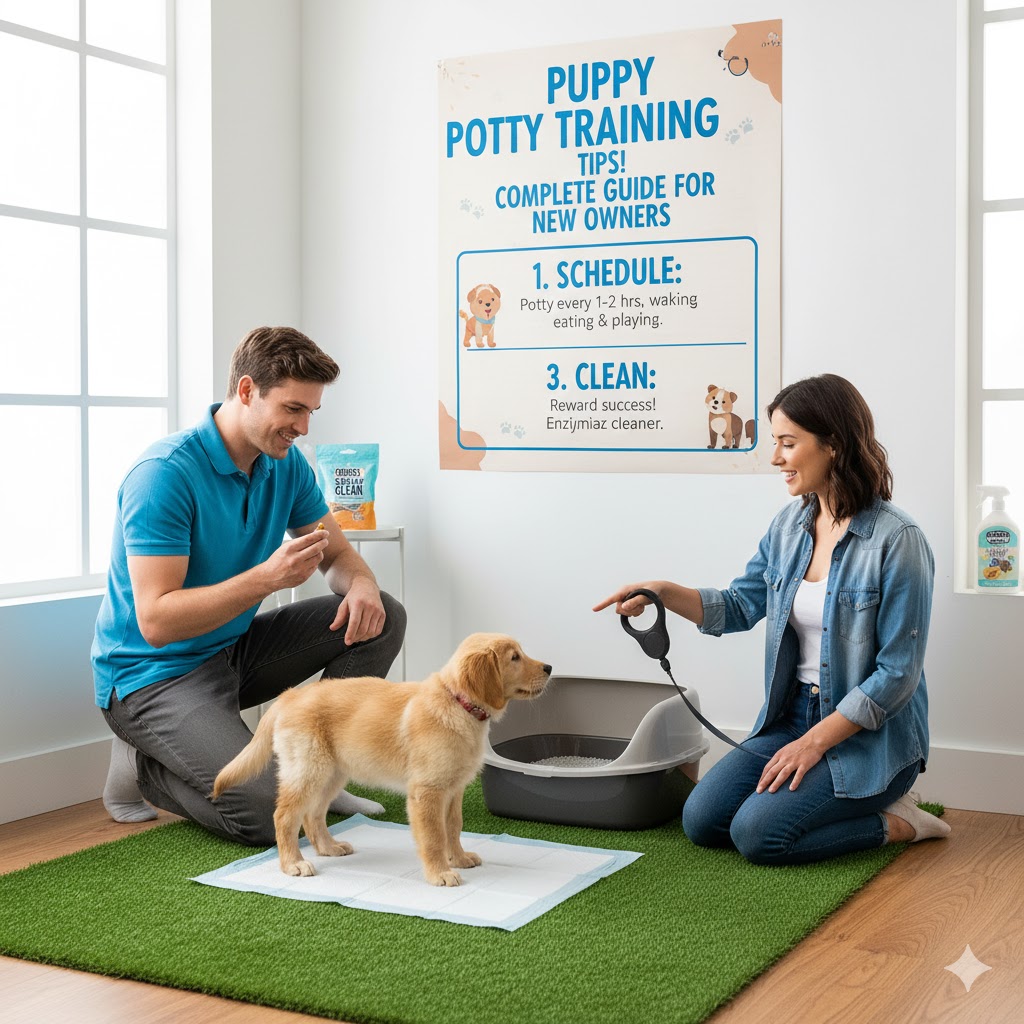“Step-by-Step Techniques, Proven Strategies, and Expert Advice Puppy Potty Training Tips
Bringing a new puppy home is exciting—but it also comes with big responsibilities. One of the very first (and most important) lessons your puppy must learn is potty training. Without a proper plan, your home can quickly turn into a mess, leaving you frustrated and your puppy confused.
Potty training (also called house training) is not just about keeping your home clean. It teaches your puppy discipline, strengthens your bond, and sets the foundation for a well-behaved adult dog.
In this ultimate guide, we’ll cover everything you need to know about puppy potty training, from the best methods, schedules, and tools, to common mistakes to avoid. By the end of this article, you’ll have a step-by-step system to make potty training easier, faster, and stress-free.
Discover more: Puppy Potty Training Tips: Complete Guide for New Owners

Discover More: Affordable Dog Grooming Tips for Busy US Pet Owners
Why Potty Training is Essential for Puppies
Potty training may feel overwhelming at first, but it comes with multiple benefits:
- Hygiene: Prevents bad odors, stains, and bacterial growth inside your home.
- Health: Reduces the risk of infections for both puppies and humans.
- Behavior: Builds discipline and structure in your puppy’s daily routine.
- Bonding: A well-trained puppy is easier to care for and strengthens trust with you.
- Convenience: Saves time and effort by avoiding constant clean-ups.
When to Start Potty Training a Puppy
Many new pet parents wonder about the right age to begin potty training.
- Ideal Age: Start at 8 weeks old. Puppies this age are capable of learning simple commands and habits.
- Younger Puppies (6–7 weeks): They can start learning basics, but full bladder control isn’t developed yet.
- Older Puppies (12+ weeks): They can be trained faster, but may already have formed bad habits.
👉 The golden rule: Start training as early as possible for the best results.
How Long Does Puppy Potty Training Take?
The answer varies depending on your puppy’s age, breed, consistency, and environment.
- Average Training Time: 4–6 months for most puppies.
- Quick Learners: Some puppies become reliable in 2–3 months.
- Stubborn Cases: Small breeds or rescue dogs may take up to a year.
Remember, patience and consistency are the keys to success.
Puppy Bladder Control: The 1-Hour Rule
A general rule of thumb is:
👉 Puppies can hold their bladder for 1 hour for every month of age.
For example:
- 2-month-old puppy = 2 hours
- 3-month-old puppy = 3 hours
- 6-month-old puppy = 6 hours
⚠️ Never expect a young puppy to “hold it” all day. Frequent potty breaks are necessary for their comfort and health.
Essential Supplies for Puppy Potty Training
Before you begin, make sure you’re prepared with the right tools:
- Crate: Helps prevent accidents and teaches control.
- Puppy Pads: Useful for apartments or temporary indoor training.
- Leash & Collar: For outdoor potty trips.
- Cleaning Products: Enzyme-based cleaners to eliminate odors.
- Treats & Rewards: For positive reinforcement.
- Training Bell (optional): Helps your puppy signal when they need to go outside.
Step-by-Step Puppy Potty Training Method
1. Create a Consistent Schedule
Dogs thrive on routine. Take your puppy out:
- First thing in the morning
- After meals
- After naps
- After playtime
- Before bedtime
- Every 2–3 hours during the day
2. Choose a Potty Spot
Pick a designated outdoor area. Puppies learn faster when they associate a smell with going potty.
3. Use a Cue Word
Say commands like “Go potty” or “Do your business” consistently.
4. Reward Immediately
Give treats, praise, or affection right after your puppy goes outside.
5. Supervise Indoors
Keep an eye on your puppy. Look for signs such as:
- Sniffing the floor
- Circling
- Whining
- Pacing near the door
6. Crate Training for Success
- A crate prevents accidents when you can’t supervise.
- The crate should be just big enough for your puppy to stand and turn around.
- Never use the crate as punishment.
7. Gradual Freedom
Once your puppy proves reliable, expand their access to the house room by room.
Puppy Potty Training by Living Situation
Potty Training in Apartments
- Use puppy pads or a balcony if outdoor access is limited.
- Stick to a strict schedule to avoid accidents.
Potty Training in Houses with Yards
- Always take your puppy to the same spot.
- Fence off a safe potty zone to avoid distractions.
Nighttime Puppy Potty Training Tips
Nighttime training is a common challenge for puppy owners.
- Limit water intake before bed (but don’t restrict too much).
- Take your puppy outside right before bedtime.
- Set an alarm to take your puppy out once during the night.
- As your puppy grows, gradually increase the time between nighttime potty breaks.
Common Mistakes Puppy Owners Make
- Punishing Accidents – Yelling or scolding creates fear, not learning.
- Inconsistent Schedule – Skipping potty breaks confuses the puppy.
- Improper Cleaning – Lingering odors encourage repeat accidents.
- Using Puppy Pads Too Long – Can delay outdoor potty training.
- Not Rewarding Quickly Enough – Rewards must come immediately.
How to Handle Puppy Accidents Indoors
Accidents are part of the learning process.
- Stay calm—never punish your puppy.
- Interrupt gently with a firm “No” if caught in the act.
- Take them outside immediately.
- Clean with an enzyme-based cleaner to remove odors completely.
Potty Training Small vs. Large Breeds
- Small Breeds (Chihuahuas, Yorkies):
- Smaller bladders = more frequent potty trips.
- Often take longer to fully train.
- Large Breeds (Labs, Shepherds):
- Can hold bladder longer.
- Usually easier to train but need consistent routines.
Special Cases
Potty Training Rescue Dogs
- May have prior bad habits.
- Be patient and use crate training.
- Establish trust before expecting fast results.
Senior Dogs
- Incontinence may develop.
- Frequent trips and pee pads may be needed.
Troubleshooting Stubborn Puppies
If your puppy isn’t making progress:
- Increase potty breaks.
- Revisit crate training.
- Keep a potty-training journal to track accidents.
- Rule out medical issues (UTIs, digestive problems).
- Seek help from a professional trainer if needed.
Advanced Training: Bell Training Method
- Hang a bell by the door.
- Teach your puppy to ring it with their paw or nose.
- Each time they ring, take them outside.
- Reinforce with praise and treats.
Positive Reinforcement Strategies
- Use high-value treats (chicken, cheese, or small store-bought treats).
- Praise enthusiastically with a happy voice.
- Never withhold love—focus on rewards, not punishment.
Travel and Puppy Potty Training
Traveling with a puppy requires extra planning.
- Take breaks every 2–3 hours.
- Use puppy pads in the car if necessary.
- Maintain a consistent schedule as much as possible.
- Bring cleaning supplies for accidents on the road.
Frequently Asked Questions (FAQ)
Q1: How often should I take my puppy outside?
👉 Every 2–3 hours and after meals, naps, or playtime.
Q2: Should I use puppy pads or go directly outdoors?
👉 Outdoors is best, but pads are useful for apartments or emergencies.
Q3: What age is too late to potty train?
👉 It’s never too late, but older puppies may take longer.
Q4: My puppy pees inside right after coming back from outside. Why?
👉 They may not have fully emptied their bladder. Stay outside longer.
Q5: How do I stop marking behavior?
👉 Neutering, supervision, and consistent reinforcement help reduce marking.
Conclusion
Potty training your puppy may seem like a challenge at first, but with patience, consistency, and the right methods, success is guaranteed.
The keys to effective potty training are:
- A structured schedule
- Positive reinforcement
- Proper tools like crates and cleaning products
- Understanding your puppy’s needs and signals
Remember: accidents are normal, but progress comes with persistence. Follow these puppy potty training tips, and soon you’ll have a happy, well-trained puppy who knows exactly where to go.
